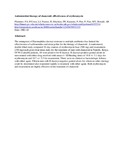| dc.contributor.author | Plummer, FA | |
| dc.contributor.author | D'Costa, LJ | |
| dc.contributor.author | Nsanze, H | |
| dc.contributor.author | Maclean, IW | |
| dc.contributor.author | Karasira, P | |
| dc.contributor.author | Piot, P | |
| dc.contributor.author | Fast, MV | |
| dc.contributor.author | Ronald, AR | |
| dc.date.accessioned | 2013-06-11T08:55:06Z | |
| dc.date.available | 2013-06-11T08:55:06Z | |
| dc.date.issued | 1983-10 | |
| dc.identifier.citation | J Infect Dis. 1983 Oct;148(4):726-31. | en |
| dc.identifier.uri | http://www.ncbi.nlm.nih.gov/pubmed/6355314 | |
| dc.identifier.uri | http://erepository.uonbi.ac.ke:8080/xmlui/handle/123456789/31333 | |
| dc.description.abstract | The emergence of Haemophilus ducreyi resistant to multiple antibiotics has limited the effectiveness of sulfonamides and tetracycline for the therapy of chancroid. A randomized, double-blind study compared 10-day courses of erythromycin base (500 mg) and rosaramicin (250 mg) each given four times daily for the treatment of men with chancroid in Nairobi, Kenya. Of 99 evaluable patients, 84 were positive for H ducreyi. H ducreyi-positive genital ulcers in men treated with either drug resolved with mean +/- SD healing times of 10.8 +/- 5.1 days for erythromycin and 10.7 +/- 5.5 for rosaramicin. There were no clinical or bacteriologic failures with either agent. Fifteen men with H ducreyi-negative genital ulcers for whom no other etiology could be determined also responded rapidly to treatment with either agent. Both erythromycin and rosaramicin are highly effective in the treatment of chancroid | en |
| dc.language.iso | en | en |
| dc.publisher | University of Nairobi, | en |
| dc.title | Antimicrobial therapy of chancroid: effectiveness of erythromycin | en |
| dc.type | Article | en |
| local.publisher | Department of Medicine | en |

